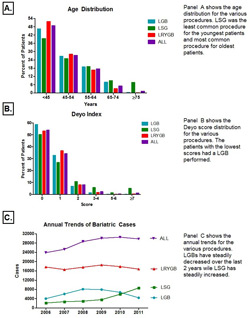
|
 |
Back to 2014 Annual Meeting Posters
A Three State Analysis of Bariatric Procedures: Trends and Outcomes
Cheguevara Afaneh*1, Gregory Giambrone2, Jonathan Eskreis-Winkler2, Akshay U. Bhat3, Ramin Zabih3, Gregory Dakin1, Alfons Pomp1, Peter Fleischut2
1Surgery, NY Presbyterian Hospital, New York, NY; 2Anesthesiology, NY Presbyterian Hospital, New York, NY; 3Cornell University, Ithaca, NY
Introduction: The popularity of bariatric surgery has continued to grow over the last decade. The safety and efficacy of bariatric surgery has been previously established. Nevertheless, trends as well as patient characteristics continue to evolve and change in bariatric surgery. Herein, we report trends and outcomes following bariatric surgery from three major states over a six-year interval using the State Inpatient Databases (SID), Healthcare Cost and Utilization Project, Agency for Healthcare Research and Quality.
Methods: Using SID data from California, Florida, and New York, we retrospectively reviewed outcomes of all laparoscopic adjustable gastric bandings (LGB), laparoscopic sleeve gastrectomies (LSG), and laparoscopic roux-en-y gastric bypasses (LRYGB) performed on obese patients from 2006 to 2011. Discharges analyzed for distribution of age and Deyo Comorbidity Index (Deyo score) by procedure. Furthermore, postoperative complications and mortality rates were compared and reported.
Results: A total of 160,472 bariatric procedures were performed during the study period; 22.2% LGB, 15.5% LSG, and 62.4% LRYGB. Overall, females had a higher frequency of bariatric surgery [Table 1]. LGB was the most frequently used procedure among males receiving bariatric procedures. The majority of patients undergoing bariatric surgery were under the age of 45 (50.4%). The highest proportion of patients undergoing LSG were > 75 were (Figure A). In general, patients with the lowest Deyo score underwent LGB (P<0.0001, Figure B). Over the last 5 years, the utilization of LGBs has decreased while the number of LSG has increased (Figure C). The number of LRYGB has remained relatively constant while the total number of bariatric procedures has increased. LSG had the highest proportion of pulmonary, cardiac and hematologic complications, while LGB had the lowest rates in the former categories (P<0.0001) [Table 1]. The incidence of postoperative ileus and nausea/vomiting was highest following LSG and lowest following LGB (P<0.0001). The length of stay was significantly shorter following LGB, while LSG and LRYGB were equivalent (P<0.0001). The proportion of mortality was lowest for LGB and highest for LSG (P<0.0001). The overall mortality for all bariatric procedures was 0.4%.
Conclusion: Bariatric surgery remains safe and feasible. LSG is becoming more popular than LGB, especially for older patients with significantly more comorbidities; however, morbidity remains higher for LSG compared to LGB. The SID has important limitations; therefore, further analyses are necessary to identify the full impact of these findings.

 Bariatric Population Trends
Back to 2014 Annual Meeting Posters
|



